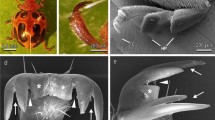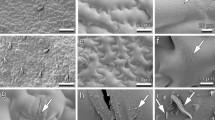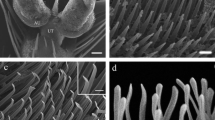Abstract
The tarsal attachment devices of the southern green stink bug Nezara viridula, a cosmopolitan pest of different crops, encompass a pair of claws, distal pretarsal smooth pulvilli, and a proximal hairy pad on the ventral basitarsus. To evaluate the role of these attachment devices in generating attachment, behavioural experiments testing locomotion of insects with ablated pulvilli, shaved hairs and cut-off claws were performed. Using traction force experiments, insect attachment performance was evaluated on artificial substrates characterised by different roughness and on two substrates with different surface energies in the air and under water. To examine the contact area of attachment devices during resting, pulling and inverted walking, intact insects and those without claws were video-recorded using a high-speed camera. The present data reveal a great involvement of pulvilli in insect attachment on all the tested surfaces, while the hairy pad seems to have a role in producing friction forces only on smooth surfaces and on surfaces with intermediate roughness. The hairy pad was revealed to be important in adhesion to hydrophobic substrates under water, a function that could be relevant for N. viridula insects in consideration that many plant leaves tend to have hydrophobic surfaces and may be often covered by water film.





Similar content being viewed by others
References
Betz O (2002) Performance and adaptive value of tarsal morphology in rove beetles of the genus Stenus (Coleoptera, Staphylinidae). J Exp Biol 205:1097–1113
Beutel RG, Gorb SN (2001) Ultrastructure of attachment specializations of hexapods (Arthropoda): evolutionary patterns inferred from a revised ordinal phylogeny. J Zool Syst Evol Res 39:177–207
Beutel RG, Gorb SN (2006) A revised interpretation of the evolution of attachment structures in Hexapoda with special emphasis on Mantophasmatodea. Arthropod Syst Phylogeny 64:3–25
Beutel RG, Gorb SN (2008) Evolutionary scenarios for unusual attachment devices of Phasmatodea and Mantophasmatodea (Insecta). Syst Entomol 33:501–510
Bullock JMR, Federle W (2009) Division of labour and sex differences between fibrillar, tarsal adhesive pads in beetles: effective elastic modulus and attachment performance. J Exp Biol 212:1876–1888
Bullock JMR, Federle W (2011) The effect of surface roughness on claw and adhesive hair performance in the dock beetle Gastrophysa viridula. Insect Sci 18(3):298–304
Bullock JMR, Drechsler P, Federle W (2008) Comparison of smooth and hairy attachment pads in insects: friction, adhesion and mechanisms for direction-dependence. J Exp Biol 211(20):3333–3343
Bußhardt P, Wolf H, Gorb SN (2012) Adhesive and frictional properties of tarsal attachment pads in two species of stick insects (Phasmatodea) with smooth and nubby euplantulae. Zoology 115(3):135–141
Clemente CJ, Federle W (2008) Pushing versus pulling: division of labour between tarsal attachment pads in cockroaches. Proc R Soc Lond B Biol Sci 275:1329–1336
Dai Z, Gorb SN, Schwarz U (2002) Roughness-dependent friction force of the tarsal claw system in the beetle Pachnoda marginata (Coleoptera, Scarabaeidae). J Exp Biol 205:2479–2488
Dirks J-H, Federle W (2011) Fluid-based adhesion in insects—principles and challenges. Soft Matter 7:11047
Eberhard MJB, Pass G, Picker MD, Beutel R, Predel R, Gorb SN (2009) Structure and function of the arolium of Mantophasmatodea (Insecta). J Morphol 270(10):1247–1261
Endlein T, Federle W (2015) On heels and toes: How ants climb with adhesive pads and tarsal friction hair arrays. PLoS One 10:1–16
Federle W (2006) Why are so many adhesive pads hairy? J Exp Biol 209:2611–2621
Federle W, Riehle M, Curtis AS, Full RJ (2002) An integrative study of insect adhesion: mechanics and wet adhesion of pretarsal pads in ants. Integr Comp Biol 42:1100–1106
Filippov A, Popov VL, Gorb SN (2011) Shear induced adhesion: contact mechanics of biological spatula-like attachment devices. J Theor Biol 276:126–131
Frantsevich L, Gorb SN (2004) Structure and mechanics of the tarsal chain in the hornet, Vespa crabro (Hymenoptera: Vespidae): implications on the attachment mechanism. Arthropod Struct Dev 33:77–89
Ghazi-Bayat A, Hasenfuss I (1980) Zur Herkunft der Adhäsionsflüssigkeit der tarsalen Haftlappen bei den Pentatomidae (Heteroptera). Zool Anz 204:13–18
Gorb SN (2001) Attachment devices of insect cuticle. Kluwer Academic Publishers, Dordrecht
Gorb SN (2005) Uncovering insect stickiness: structure and properties of hairy attachment devices. Am Entomol 51:31–35
Gorb SN (2007) Visualisation of native surfaces b 414 y two-step molding. Microsc Today 15:44–46
Gorb SN (2008) Smooth attachment devices in insects: Functional morphology and biomechanics. In: Casas J, Simpson SJ (eds) Advances in insect physiology: insect mechanics and control, vol 34. Academic Press, London, pp 81–115
Gorb EV, Gorb SN (2009) Functional surfaces in the pitcher of the carnivorous plant Nepenthes alata: a cryo-SEM approach. In: Gorb SN (ed) Functional surfaces in biology—adhesion related phenomena, vol 2. Springer, Dordrecht, pp 205–238
Gorb SN, Jiao Y, Scherge M (2000) Ultrastructural architecture and mechanical properties of attachment pads in Tettigonia viridissima (Orthoptera, Tettigoniidae). J Comp Physiol A Neuroethol Sens Neural Behav Physiol 186:821–831
Gorb EV, Hosoda N, Miksch C, Gorb SN (2010) Slippery pores: anti-adhesive effect of nanoporous substrates on the beetle attachment system. J R Soc Interface 7:1571–1579
Heepe L, Kovalev AE, Gorb SN (2014) Direct observation of microcavitation in underwater adhesion of mushroom-shaped adhesive microstructure. Beilstein J Nanotechnol 5:903–909
Hosoda N, Gorb SN (2012) Underwater locomotion in a terrestrial beetle: combination of surface de-wetting and capillary forces. Proc R Soc Lond B Biol Sci 279:4236–4242
Koch K, Barthlott W (2009) Superhydrophobic and superhydrophilic plant surfaces: an inspiration for biomimetic materials. Philos Trans A Math Phys Eng Sci 367:1487–1509
Labonte D, Federle W (2013) Functionally different pads on the same foot allow control of attachment: Stick insects have load-sensitive “heel” pads for friction and shear-sensitive “toe” pads for adhesion. PLoS One 12:e81943
Labonte D, Williams JA, Federle W (2014) Surface contact and design of fibrillar “friction pads” in stick insects (Carausius morosus): mechanisms for large friction coefficients and negligible adhesion. J R Soc Interface 11(94):20140034
Panizzi AR, McPherson JE, James DG, Javaheri M, McPherson RM (2000) Stink bugs (Pentatomidae). In: Schaefer CW, Panizzi AR (eds) Heteroptera of economic importance. CRC Press, Boca Raton, pp 421–474
Peressadko AG, Gorb SN (2004) Surface profile and friction force generated by insects. In: Boblan I, Bannasch R (eds) First International Industrial Conference Bionik. VDI Verlag, Düsseldorf, pp. 257–261
Ploem JS (1975) Reflection-contrast microscopy as a tool for investigation of the attachment of living cells to a glass surface. In: van Furth R (ed) Mononuclear phagocytes in immunity, infection and pathology. Blackwell, Oxford, pp 405–421
Rebora M, Michels J, Salerno G, Heepe L, Gorb E, Gorb S (2018) Tarsal attachment devices of the southern green stink bug Nezara viridula (Heteroptera: Pentatomidae). J Morphol. https://doi.org/10.1002/.jmor.20801
Roth LM, Willis ER (1952) Tarsal structure and climbing ability of cockroaches. J Exp Biol 119:483–517
Salerno G, Rebora M, Gorb EV, Kovalev A, Gorb SN (2017) Attachment ability of the southern green stink bug Nezara viridula (Heteroptera: Pentatomidae). J Comp Physiol A Neuroethol Sens Neural Behav Physiol 203(8):1–11
Schneider CA, Rasband WS, Eliceiri KW (2012) NIH Image to ImageJ: 25 years of image analysis. Nature methods 9(7):671–675
Scholz I, Bückins L, Dolge L, Erlinghagen T, Weth A, Hischen F, Mayer J, Hoffmann S, Riederer M, Riedel M, Baumgartner W (2010) Slippery surfaces of pitcher plants: nepenthes wax crystals minimize insect attachment via microscopic surface roughness. J Exp Biol 213:1115–1125
Sokal RR, Rohlf FJ (1998) Biometry. W. E. Freeman and Company, New York
Song Y, Dai Z, Wang Z, Ji A, Gorb SN (2016) The synergy between the insect-inspired claws and adhesive pads increases the attachment ability on various rough surfaces. Sci Rep 6: N 26219
StatSoft I (2001) Statistica (Data Analysis Software System), Version 6. StatSoft Italia S.r.l., Italy
Stork NE (1980) Experimental analysis of adhesion of Chrysolina polita (Chrysomelidae: Coleoptera) on a variety of surfaces. J Exp Biol 88:91–107
Todd JW (1989) Ecology and behavior of Nezara viridula. Annu Rev Entomol 34:273–292
Voigt D, Schuppert JM, Dattinger S, Gorb SN (2008) Sexual dimorphism in the attachment ability of the Colorado potato beetle Leptinotarsa decemlineata (Coleoptera: Chrysomelidae) to rough substrates. J Insect Physiol 54:765–776
Voigt D, Takanashi T, Tsuchihara K, Yazaki K, Kuroda K, Tsubaki R, Hosoda N (2017) Strongest grip on the rod: tarsal morphology and attachment of Japanese pine sawyer beetles. Zool Lett 3(1):16
Wolff JO, Gorb SN (2012) Surface roughness effects on attachment ability of the spider Philodromus dispar (Araneae, Philodromidae). J Exp Biol 215:179–184
Zhou Y, Robinson A, Steiner U, Federle W (2014) Insect adhesion on rough surfaces: analysis of adhesive contact of smooth and hairy pads on transparent microstructured substrates. J R Soc Interface 11(98):20140499
Zurek DB, Gorb SN, Voigt D (2015) Locomotion and attachment of leaf beetle larvae Gastrophysa viridula (Coleoptera, Chrysomelidae). Interface Focus 5:20140055
Zurek DB, Gorb SN, Voigt D (2017) Changes in tarsal morphology and attachment ability to rough surfaces during ontogenesis in the beetle Gastrophysa viridula (Coleoptera, Chrysomelidae). Arthropod Struct Dev 46:130–137
Acknowledgements
This work was supported by the European Cooperation in Science and Technology, EMBA COST Action CA15216, STSM Grant (ECOST-STSM-CA15216-220617-088785) at the Zoological Institute, Functional Morphology and Biomechanics, Christian-Albrechts-Universität, Kiel, Germany.
Author information
Authors and Affiliations
Contributions
The study was designed by all the authors. SG performed the cryo-scanning electron microscopy investigations. GS and MR performed the traction force experiments. EG and AK characterized the tested surfaces. The manuscript was written by GS, MR and EG. All authors discussed the analysis and interpretation of the results and participated in the final editing of the manuscript.
Corresponding author
Ethics declarations
Conflict of interest
The authors declare that they have no conflict of interest.
Rights and permissions
About this article
Cite this article
Salerno, G., Rebora, M., Kovalev, A. et al. Contribution of different tarsal attachment devices to the overall attachment ability of the stink bug Nezara viridula. J Comp Physiol A 204, 627–638 (2018). https://doi.org/10.1007/s00359-018-1266-0
Received:
Revised:
Accepted:
Published:
Issue Date:
DOI: https://doi.org/10.1007/s00359-018-1266-0




